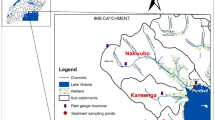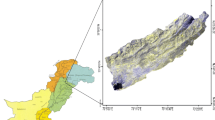Abstract
One of the main challenges in controlling soil erosion and sediment load in desert areas is the lack of data. Therefore, estimation of soil erosion in such watersheds is possible by determining the sediment delivery ratio (SDR). The purpose of this study is comparison of the results of different methods for calculating SDR with its actual amount in arid areas and determining the best method. The study areas include 6 watersheds for calibration phase and 1 watershed for validation phase in Semnan province in the north of Iran. The volume of trapped sediment upstream the study area check-dams was calculated by evaluating the changes in the dams’ reservoirs morphological characteristics between successive events. The rain simulator method was used to obtain actual SDR. The SDR value was also calculated using 14 empirical methods. Comparison of observed and calculated SDR values indicates the different performance of the empirical methods. It is not possible to introduce one of these methods for calculating SDR in all studied basins, but due to the lowest relative error rate of the USDA-SCS (1983) model, this model was calibrated. The relative mean squared error for calibrated model was 0.2241 (low error). The results obtained by the calibrated model corresponded to about 80% to the values of the observed SDR. Finally, the relative error rate in the validation stage for the basin that was used in validation of the calibrated model was calculated as 1.17%, so the results of the calibrated model can be accepted.






Similar content being viewed by others
References
Afsari R, Ghoddosi J (2011) Evaluation of sediment delivery ratio (SDR) estimation methods under different climatic conditions (Case study: Markazi watershed). J Phys Geogr 4(12):107–118. https://www.sid.ir/en/Journal/ViewPaper.aspx?ID=212750
American Society of Civil Engineers (2006) Sedimentation engineering: issue 54 of ASCE manuals and reports on engineering practice. ASCE, Reston
Asghari Saraskanrud S, Hosseinollahpour, M (2013) Investigation of sediment delivery ratio (SDR) in Jajroud river basin. Quantitative Geomorphological Research 2(1):67–78.
Bayat R, Moradi S (2013) Review of research conducted on the Sediment Delivery Ratio. Extension and Development of Watershed Managment J 5(2):27–37
Bouguerra S, Jebari S (2017) Identification and prioritization of sub-watersheds for land and water management using InVEST SDR model: Rmelriver basin, Tunisia. Arab J Geosci 10:348. https://doi.org/10.1007/s12517-017-3104-z
Boyce RC (1975) Present and prospective technology for predicting sediment yields and sources. In: Boyce RC (ed) Sediment routing with sediment delivery ratios. Agricultural Research Service, U.S. Department of Agriculture, Oxford, pp 61–65
Di Stefano C, Ferro V (2018) Modelling sediment delivery using connectivity components at the experimental SPA2 basin, Sicily (Italy). J Mt Sci 15:1868–1880. https://doi.org/10.1007/s11629-018-4956-8
Ebrahimzadeh S, Motagh M, Mahboub V, Mirdar Harijan F (2018) An improved RUSLE/SDR model for the evaluation of soil erosion. Environ Earth Sci 77:454. https://doi.org/10.1007/s12665-018-7635-8
Farhoodi M, Mirzaei H, Kavyan A, Safari A (2015) Comparison and evaluation of different methods to estimate sediment delivery ratio in three different climates of Iran. Geogr Environ Plan 26(3):255–274 http://gep.ui.ac.ir/article_18742.html
Hamed Y, Albergel J, Asseline J, Nasri S, Zante P, Berndtsson R, Niyazi M, Balah M (2002) Comparison between rainfall simulator erosion and observed sedimentation in an erosion-sensitive semiarid catchment. J Catena 50:16–21
Hashemi A, Sarreshtehdari A, Lotfollahzadeh D, Ghodrati M, Mazdarani B, Mosavinejhad SM, Salar M, Jafari A (2017) Investigating and determining erosivity index in different regions of Iran (Semnan Province). Soil conservation and Watershed Management Research Institute 56 pages
Jinze M, Qingmei M (1981) Sediment delivery ratio as used in the computation of watershed sediment yield. J Hydrol N Z 20(1):27–38 Accessed June 1, 2020. www.jstor.org/stable/43945093
Maner SB (1962) Factors influencing sediment delivery ratios in the Blackland Prairie land resource area.US Dept. of Agriculture, Soil Conservation Service, Fort Worth, Texas, USA.
Meyer LD (1994) Rainfall simulators for soil conservation research. In: Lal R (ed) Soil erosion research methods. Soil and Water Conserv. Soc, Ankeny, pp 83–103
Molina-Navarro E, Martínez-Pérez S, Sastre-Merlín A, Bienes-Allas R (2014) Catchment erosion and sediment delivery in a Limno-reservoir basin using a simple methodology. Water Resour Manag 28:2129–2143. https://doi.org/10.1007/s11269-014-0601-7
Nash JE, Sutcliffe JV (1970) River flow forecasting through conceptual models, part 1-a discussion of principles. J Hydrol 10(3):282–290. https://doi.org/10.1016/0022-1694(70)90255-6
Olii MR, AKironoto BA, Yulistiyanto B, Sunjoto D (2017) Determining sediment delivery ratio of catchment of reservoir in Java. Prosiding Konferensi Nasional Pascasarjana Teknik Sipil (KNPTS) ISBN 2477-00-86
Renfro GW (1975) Use of erosion equations and sediment-delivery ratios for predicting sediment. Sediment Yield. In: Present and prospective technology for predicting sediment yields and sources. Agricultural Research Service, U.S. Department of Agriculture, Oxford, pp 33–45
Skagen SK, Burris LE, Granfors DA (2016) Sediment accumulation in prairie wetlands under a changing climate: the relative roles of landscape and precipitation. Wetlands 36:383–395. https://doi.org/10.1007/s13157-016-0748-5
United States Department of Agriculture, Soil Conservation Service (1985) National engineering handbook. Section 3, sedimentation. U.S. Dept. of Agriculture, Soil Conservation Service, Washington, D.C https://directives.sc.egov.usda.gov/viewerFS.aspx?id=3880
USDA-SCS (1971) National engineering handbook. Section 3, Sedimentation. Washington, D.C. U.S. Dept. of Agriculture, Soil Conservation Service
USDA-SCS (1983) National engineering handbook. Section 3, Sedimentation. Washington, D.C. U.S. Dept. of Agriculture, Soil Conservation Service. https://directives.sc.egov.usda.gov/OpenNonWebContent.aspx?content=18375.wba
Wang L, Yao W, Tang J, Wang WL, Hou X (2018) Identifying the driving factors of sediment delivery ratio on individual flood events in a long-term monitoring headwater basin. J Mt Sci 15:1825–1835. https://doi.org/10.1007/s11629-017-4739-7
Williams JR (1975) Sediment routing from agricultural watersheds. J Am Water Res Assoc (JAWRA) 11(5):965–974. https://doi.org/10.1111/j.1752-1688.1975.tb01817.x
Williams JR (1977) Sediment delivery ratios determined with sediment and runoff models. Proceedings Symposium on Erosion and Solid Matter Transport in Inland Water. IAHS Publ 122:168–179 http://hydrologie.org/redbooks/a122/iahs_122_0168.pdf
Williams JR, Berndt HD (1977) Sediment yield prediction based on watershed hydrology. Transac Am Soc Agricult Biol Eng 20(6):1100–1104. https://doi.org/10.13031/2013.35710
Woznicki SA, Nejadhashemi AP (2013) Spatial and temporal variabilities of sediment delivery ratio. Water Resour Manag 27:2483–2499. https://doi.org/10.1007/s11269-013-0298-z
Zheng M, Li R, He J, Cui M (2015) Sediment delivery across multiple spatio-temporal scales in an agriculture watershed of the Chinese Loess Plateau. J Mt Sci 12:1241–1253. https://doi.org/10.1007/s11629-014-3187-x
Acknowledgements
We thank Faculty of Desert Studies of Semnan University for providing us with the facilities of Geo-Erosion Laboratory.
Author information
Authors and Affiliations
Contributions
This research is derived from the doctoral dissertation of HE (PhD student). The stages of field studies, sampling, mapping, and laboratory work were done by HE with the guidance of the supervisors of the dissertation (SN and SAAH). Data analysis and writing the article have been carried out in collaboration with all authors.
Corresponding author
Ethics declarations
Conflict of interest
The authors declare no conflict of interests. In addition, the ethical issues, including plagiarism, informed consent, misconduct, data fabrication and/or falsification, double publication and/or submission, and redundancy have been completely observed by the authors.
Additional information
Responsible editor: Broder J. Merkel
Highlights
• Sediment delivery ratio in check-dams in small catchments in arid regions of Iran show very drastic changes.
• Comparison of observed and calculated SDR values indicates the different performance of the empirical relationships. So that a relationship for one watershed has had acceptable results, for another watershed has had inappropriate results.
• The estimated SDR values by the calibrated USDA-SCS (1983) model were 80% consistent with the values of the observed sediment delivery ratio in the studied watersheds.
Rights and permissions
About this article
Cite this article
Etemadi, H., Nikoo, S. & Hashemi, S.A.A. Introducing an appropriate empirical method for estimating sediment delivery ratio (SDR) via sedimentometry of check-dams in small catchments in arid regions (Semnan province, Iran). Arab J Geosci 14, 1174 (2021). https://doi.org/10.1007/s12517-021-07322-w
Received:
Accepted:
Published:
DOI: https://doi.org/10.1007/s12517-021-07322-w




